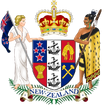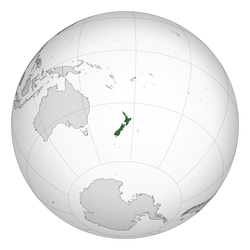|
Aotearoa | |

|

|
| Anthem God Defend New Zealand God Save the Queen | |
| Capital | Wellington |
| Monarch | |
| - From 1952 | Elizabeth II |
| Governor-General | |
| - From 2006 | Sir Anand Satyanand |
| Prime Minister | |
| - From 2008 | John Key |
| Legislature | House of Representatives |
| History | |
| - May 25, 1854 | 1st Parliament |
| - September 26, 1907 | Dominion |
| - December 11, 1931 | Statute of Westminster |
| - November 25, 1947 | Statute of Westminster Adopted |
| - December 13, 1986 | Constitution Act 1986 |
| Commonwealth accession | December 11, 1931 |
| Area | 268,021 km² |
| Population | |
| - 2010 | 4,393,500 |
| Density | 16.3/km² |
| GDP | 2010 (PPP) |
| - Total | US$ 126.1 billion |
| - Per capita | US$ 28,722 |
| Currency | New Zealand dollar |
| v | |
New Zealand is a parliamentary democracy in Oceania, and a part of the Realm of New Zealand.
Background
The Polynesian Maori reached New Zealand in about A.D. 800. In 1840, their chieftains entered into a compact with Britain, the Treaty of Waitangi, in which they ceded sovereignty to Queen Victoria while retaining territorial rights. In that same year, the British began the first organized colonial settlement. A series of land wars between 1843 and 1872 ended with the defeat of the native peoples. The British colony of New Zealand became an independent dominion in 1907 and supported the UK militarily in both World Wars. New Zealand's full participation in a number of defense alliances lapsed by the 1980s. In recent years, the government has sought to address longstanding Maori grievances.[1]
Economy
Over the past 20 years the government has transformed New Zealand from an agrarian economy dependent on concessionary British market access to a more industrialized, free market economy that can compete globally. This dynamic growth has boosted real incomes - but left behind some at the bottom of the ladder - and broadened and deepened the technological capabilities of the industrial sector. Per capita income rose for ten consecutive years until 2007 in purchasing power parity terms, but fell in 2008-09. Debt-driven consumer spending drove robust growth in the first half of the decade, helping fuel a large balance of payments deficit that posed a challenge for economic managers. Inflationary pressures caused the central bank to raise its key rate steadily from January 2004 until it was among the highest in the OECD in 2007-08; international capital inflows attracted to the high rates further strengthened the currency and housing market, however, aggravating the current account deficit. The economy fell into recession before the start of the global financial crisis and contracted for five consecutive quarters in 2008-09. In line with global peers, the central bank cut interest rates aggressively and the government developed fiscal stimulus measures. The economy posted a 1.7% decline in 2009, but pulled out of recession late in the year, and achieved 2.1% growth in 2010. Nevertheless, key trade sectors remain vulnerable to weak external demand. The government plans to raise productivity growth and develop infrastructure, while reining in government spending.[2]
Monarch
- Elizabeth II (₩) (February 6, 1952 - )
Governor-General
- Sir Anand Satyanand (₩) (August 23, 2006 - )
Prime Minister
- John Key (₩) (November 19, 2008 - )
Nation
New Zealand Polities
Realm of New Zealand (From 1983)
Realm of New Zealand: Cook Islands (From 1965)
Realm of New Zealand: Niue (From 1974)
Tokelau (From 1949)
New Zealand Antarctic Territory (From 1923)
Neighbouring Nations
References
- New Zealand: Guide to Law Online (Library of Congress)
- New Zealand: Location Map 2013 (UN OCHA, PNG)
- New Zealand: Maps (CIA)
- The World Factbook (CIA)
- Chiefs of State and Cabinet Members of Foreign Governments (CIA)
- U.S. Department of State
- Australian Government
- Commonwealth of Nations
- Inter-Parliamentary Union - House of Representatives
- BBC News Country Profile
- BBC News Time Line
- World Statesmen.org
- International Constitutional Law Project
- Psephos Election Archive
- Wikisource 1911 encyclopedia project
- Wikipedia
